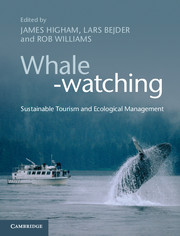Book contents
- Frontmatter
- Dedication
- Contents
- Acknowledgements
- List of contributors
- List of abbreviations
- 1 Tourism, cetaceans and sustainable development
- Part I The historical and contemporary contexts
- 2 Threats facing cetacean populations
- 3 From exploitation to adoration
- 4 Human attitudes and values
- 5 The whale-watching industry
- 6 The International Whaling Commission (IWC) and whale-watching
- Part II Human dimensions of whale-watching
- Part III Ecological dimensions of whale-watching
- Part IV Sustainable management: insights and issues
- Index
- Plate Section
- References
2 - Threats facing cetacean populations
The global context
from Part I - The historical and contemporary contexts
Published online by Cambridge University Press: 05 April 2014
- Frontmatter
- Dedication
- Contents
- Acknowledgements
- List of contributors
- List of abbreviations
- 1 Tourism, cetaceans and sustainable development
- Part I The historical and contemporary contexts
- 2 Threats facing cetacean populations
- 3 From exploitation to adoration
- 4 Human attitudes and values
- 5 The whale-watching industry
- 6 The International Whaling Commission (IWC) and whale-watching
- Part II Human dimensions of whale-watching
- Part III Ecological dimensions of whale-watching
- Part IV Sustainable management: insights and issues
- Index
- Plate Section
- References
Summary
Introduction
This chapter provides a brief introduction to the current state of knowledge of threats facing cetacean populations globally, through interviews with some of the leading researchers in the field. Understanding the global status of cetacean populations, and the threats that they face, is critically important to their conservation. This chapter considers the global status of cetacean populations, the information needs required to manage those populations, anthropogenic stressors (including whale-watching), and approaches to understanding the effects of sublethal stressors on cetacean populations. Informed by one-on-one discussions with a diverse group of cetacean experts around the world, this chapter highlights the challenges inherent in seeking to accurately and confidently assess the status of cetacean populations. Yet it is critically important within the context of species conservation to have some appreciation of the status of cetacean populations, and the myriad threats that they face. A great deal of research in recent decades has gone into developing quantitative methods to estimate the size of cetacean populations and to evaluate the sustainability of human-caused mortality through direct harvest or indirect removals, such as by-catch in fishing gear or ship strikes. In recent years, much of the work of marine mammal conservation has been focused on understanding the ways that non-lethal threats, such as ocean noise or reduction of prey species through overfishing, could cause population-level effects. This chapter provides a brief introduction to those broad themes, but really, each topic deserves a chapter (at least) in its own right. Readers are strongly encouraged to explore the publications of the following experts for a more thorough treatment of these disciplines.
- Type
- Chapter
- Information
- Whale-watchingSustainable Tourism and Ecological Management, pp. 19 - 30Publisher: Cambridge University PressPrint publication year: 2014
References
- 1
- Cited by



